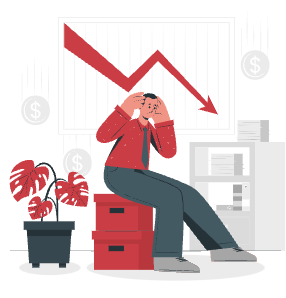College Statistics in the U.S. in 2023
College enrollment can be driven by a range of factors, including personal and financial considerations. If you’re interested in exploring college statistics in the U.S., we encourage you to read on.

Key Takeaways: March 2023 Data
✓ There are 4,360 higher education institutions in total in the U.S., and 2,832 of them are four-year colleges/universities.(Research.com)
✓ According to an annual survey conducted by U.S. News for the 2022-2023 academic year, tuition and fees at ranked private colleges have increased by around 4% on average. (USnews)
✓ In public 4-year colleges, approximately 8 million students are enrolled, and last year, there were approximately 10.2 million applications made to universities in the United States.
✓ Students at private pay $54,501 annually, leading to a total expense of $218,004 over a four-year program.
✓As of fall 2022, there were around 17.9 million students enrolled in degree-granting colleges and universities in the U.S.(BestColleges)
✓ The total number of enrolled students experienced a YoY decline of 3.29% in 2023, marking the most significant rate of enrollment decrease since 1951.
✓ At a public 4-year in-state institution, the average cost results in a total cost of $102,828, and for 1-year in-state institution, the average cost is $25,707. (Education Data Initiative)
✓ There was a 16.2% decline in enrollment at community colleges.(BestColleges)
✓ In contrast, graduate enrollment has risen by 4.2%.
✓ As of September 2022, student loan debt in the United States has reached a total of $1.76 trillion.(Nerdwallet)
✓ The average GPA for students attending four-year colleges in the US is approximately 3.15, which equates to a B average.
Section 01
Average Public College Cost
Section 02
Average Private College Cost
Section 03
Average College GPA
Section 04
College Enrollment Statistics
Section 05
Percentage of College Graduates
Section 06
College Dropout Rates
Section
01
Average Public College Cost
There is a difference in the cost of attending public and private colleges. To learn more about the variation in prices, we encourage you to read further.

For in-state students, the average total cost of attending a public college is $25,290.
On average, out-of-state students are required to pay $40,940 to attend college.
The majority of students pay tuition fees that fall between the range of $6,000 to $15,000.
According to the Community College Review, the average cost of attending a community college for in-state students is $4,864.
Public community colleges charge an average of $8,622 per year for out-of-state students.
For both two-year and four-year public colleges, New England had the highest average tuition costs for in-district and in-state students, excluding room and board expenses.
On the other hand, the South had the lowest average public four-year tuition of $9,290.
The West had the lowest average tuition for public two-year schools, which was $2,380.
Over the span of a decade, western states experienced the highest rise in public two-year and four-year tuition, increasing by 62% and 60%, respectively, according to College Board data.
In contrast, public two-year and four-year colleges in the Midwest witnessed a much lower increase of 22% and 21%, respectively, over the past decade.
The data indicates that New Hampshire charges the highest in-state tuition fees of $16,070.
This is approximately $3,500 more than South Dakota's out-of-state tuition fees of $12,480.
Wyoming has the least expensive in-state tuition, which costs only $5,220.
On the other hand, Vermont has the highest out-of-state tuition and the most expensive average tuition on the list, with a price of $38,990.
The median tuition and fees paid by four-year undergraduate students is $12,090.
Most students fall in the range of $6,000 to $15,000.

Section
02
Average Private College Cost
Many students believe they can only afford one type of school because private colleges usually have a higher cost of tuition and fees compared to public ones.
The typical overall expenditure for private colleges amounts to $50,900.
The yearly average tuition fee for private community colleges is around $15,460.
Private 4-year colleges charge a tuition fee of $34,740.
The expense for books and supplies for private four-year colleges is $1,220.
On the other hand, private nonprofit four-year institutions have a median cost of $35,260, which is more than three times higher than the previous mentioned cost.
A notable percentage of students enrolled in private nonprofit four-year institutions pay tuition fees that fall between the range of $33,000 to $51,000.
Private colleges continued their rising trend of providing historically high average tuition discounts to students for the 2021-2022 academic year.
For the year, the average tuition discount for undergraduates was estimated to be almost 50%.
In 2021-2022, around 89.5% of first-time, full-time freshmen who attended private nonprofit colleges received an institutional grant or scholarship.
The average borrowing of those who graduated from a ranked private college in 2020 was $32,029.
On the other hand, graduates from public colleges borrowed an average of $26,627.
According to U.S. News data, the tuition and fees for the 2022-2023 academic year were about $39,700 on average at ranked private schools.
Out of the 911 ranked private colleges that disclosed their 2022-2023 tuition and fees, over 180 colleges have listed prices exceeding $50,000 for the academic year.
A meager 63 private colleges disclosed yearly tuition and fees that were below $20,000.
Section
03
Average College GPA
This section presents information on average GPAs at various types of colleges and across different college majors.

Students attending four-year colleges in the US generally maintain an average GPA of 3.15, equivalent to a B grade point average.
On average, public schools tend to have a GPA of approximately 3.1.
In contrast, private schools typically have an average GPA of 3.3.
On average, science majors tend to achieve lower GPAs.
The GPA for Social Science majors is 3.11.
The GPA for Science/Math majors is 3.13.
For Biology majors the GPA is 3.17.
For Engineering majors the GPA is 3.24.
For Humanities Majors the GPA is 3.25.
For Arts majors the GPA is 3.29.
For Environment Economics and Policy majors the GPA is 2.96.
The GPA for Engineering Physics majors is 3.1.
Chemistry majors have a GPA of 3.13 on average.
On average, Data Science majors achieve a GPA of 3.24.
The average GPA for Legal Studies majors is 3.28.
The average GPA for Architecture majors is 3.33.
Urban Studies majors have an average GPA of 3.35.
The average GPA for Chemical Engineering majors is 3.37.
Materials Science and Engineering majors achieve an average GPA of 3.4.
On average, Social Welfare majors have a GPA of 3.43.
Research data from the University of California, Berkeley suggests that majors centered around math and science, including engineering majors, are typically the most challenging programs to pursue, as indicated by their lower average GPAs.
The average GPA for Operations Research majors is 3.69.
Colleges with an acceptance rate of less than 15% are considered highly selective.
Colleges with an acceptance rate ranging from 20-50% are classified as selective, while colleges with an acceptance rate above 50% are considered less selective.

Section
04
College Enrollment Statistics
Over the past decade, there has been a general decline in college enrollment despite nearly 18 million students currently enrolled in U.S. colleges.
There were 17.9 million students enrolled in a postsecondary institution in 2022.
Roughly 15 million students were enrolled in an undergraduate program.
Around 3.1 million students were enrolled in a graduate-level program.
Data from the National Center for Education Statistics (NCES) shows that college enrollment started to decline in 2010 after continuously rising since the 1970s.
The rate of immediate college enrollment in high school has decreased over the past two decades, following a 14 percentage point increase between 1980 and 2000.
The Bureau of Labor Statistics reported that in 2021, 61.8% of recent high school graduates aged 16-24 were enrolled in college.
Since the semester before the pandemic began in fall 2019, total college enrollment (including both graduate and undergraduate students) has decreased by 5.7%.
During that same period, undergraduate enrollment saw a decrease of 7.6%.
Around 7.6 million college students, which accounts for approximately 42%, were enrolled in four-year public institutions in the fall of 2022.
There were 8.6 million students pursuing a bachelor's degree.
4.4 million students were enrolled in associate degree programs.
Approximately 3.1 million students were enrolled in graduate-level programs.
Around 14 million college students, accounting for 74% of total enrollment, were enrolled in at least one distance education course. In contrast, in 2019, only 37% of students were enrolled in online courses.
Nearly 46% of college students were enrolled solely in online courses, indicating a 151% rise from the preceding year.
In comparison to the undergraduate student population (with 10.6% and 17.5%), the graduate student population shows lower representation of Black and Latinx students (with 9.8% and 9.1%, respectively).
The graduate student population has a higher representation of international students than the undergraduate student population (4.5% compared to 1%).
Section
05
Percentage of College Graduates
Graduating from college is a significant achievement, and you can learn more about the demographics and graduation rates by reading further.

Statistics on college graduation reveal that the most in-demand degree is a bachelor's degree, with 2.038 million awarded in 2020.
Out of all the high school graduates who started college as freshmen this year, only 25% will be able to graduate within four years.
The graduation rate is higher for students pursuing four-year bachelor's degrees in college, with 60% of them expected to graduate, compared to the overall college student population, where only 41% are projected to graduate.
Just 18% of students who obtained a bachelor's degree were able to complete their studies within four years.
The graduation rate for students pursuing associate's degrees, which typically take two years to complete, is only 31.6%.
There has been a 15% increase in graduation rates at public colleges since 2010.
STEM (science, technology, engineering, mathematics) fields account for the majority of college graduates, with 730,394 individuals, or 18.3%, holding degrees in these areas.
Business degrees are obtained by 699,505 individuals, which constitutes 16.7% of all graduates.
15.8% of graduates, equivalent to 631,486 individuals, earned degrees in healthcare, while liberal arts and sciences degrees were earned by 11.1% of all graduates, which amounts to 444,754 individuals.
Education degrees were earned by only 4% of graduates, whereas white or Caucasian students pursuing bachelor’s degrees have a five-year graduation rate of 62.2%.
Out of all college graduates, 2,410,070 individuals, or 59.1%, identify as White or Caucasian.
Students who identify as Hispanic or Latino and are pursuing a bachelor’s degree have a graduation rate of 41.5% within five years.
13.1% of college graduates, equivalent to 532,720 individuals, identify as Hispanic or Latino.
Black or African American students pursuing a bachelor’s degree have a graduation rate of 40.5% within five years.
Out of all college graduates, only 1% identify as Black or African American.
6.7% of college graduates, which is 272,410 individuals, are non-residents.
Out of the non-resident graduates, 21,140 individuals, or 7.8%, earned 1.9% of associate’s degrees.
Students who identify as Asian/Pacific Islander and are pursuing a bachelor’s degree have a graduation rate of 69.3% within five years.
Students who identify as of two or more races and are pursuing a bachelor’s degree have a graduation rate of 50.4% within five years.
Of all college graduates, 116,350 individuals, or 2.9%, identify as of two or more races.
Since the turn of the 20th century, women have made significant progress in overcoming gender inequality in education.
Starting from 2015, women surpassed men in the number of bachelor’s degrees awarded and also made significant strides in other fields.
At private nonprofit institutions, 70% of women are able to graduate.
At private for-profit institutions, only 25% of women are able to graduate.
Women have a college graduation rate of 64% at public institutions.
Within private, nonprofit institutions, 64% of males obtain their graduation.
Within private, for-profit institutions, 26% of males obtain their graduation.
Within five years, only 8% of college students who enroll in bachelor’s programs at the age of 18 or younger manage to graduate.
Only 9% of individuals who enroll in bachelor’s programs at age 19 manage to graduate within five years.
Out of the individuals who enroll in bachelor’s programs between the ages of 20 and 23, only 4% are able to graduate within five years.
California accounts for 12% of all annual college graduates who earn their degrees.
Graduates from the District of Columbia have the highest likelihood of possessing advanced degrees.
The majority of graduates in Wyoming and New Mexico are those who have earned associate’s degrees.
The percentage of Boulder, Colorado residents who have completed college is 5%.

Section
06
College Dropout Rates
Despite a decline in high school dropout rates, the United States continues to grapple with a challenging 40% annual college dropout rate. American universities are struggling to tackle this ongoing problem, with only 41% of students graduating within four years without delay.
The dropout rate among undergraduate college students is 40%.
The dropout rate for freshmen is 30%.
College dropouts have an unemployment rate of 18.6%.
Among college dropouts, 40% come from families where neither parent completed college.
Students who have taken out larger student loans or have no loans are more likely to drop out compared to those with smaller loans.
Dropping out of college results in a missed annual income opportunity of $3.8 billion.
The probability of dropping out of college is the lowest among students who are under 19 years old.
Subsequently, those who are over 30 years old have a comparatively low likelihood of dropping out.
The age group with the highest probability of dropping out of college is students aged between 20 and 29.
The percentage of students who drop out of two-year associate programs is 35%.
The dropout rate for four-year baccalaureate degree programs is only 10%.
According to statistics, 40% of college dropouts had a GPA of 3.0 or higher.
Even more surprising, 40% of college dropouts have achieved a B average or better.
